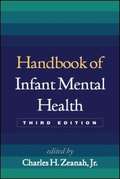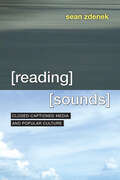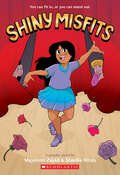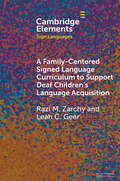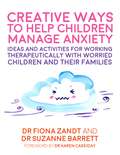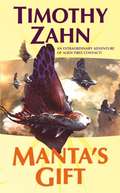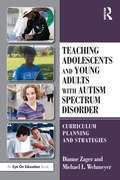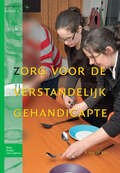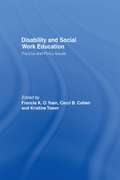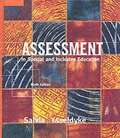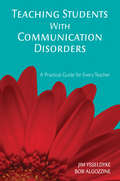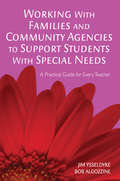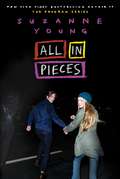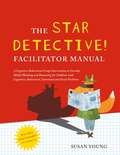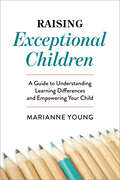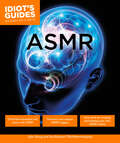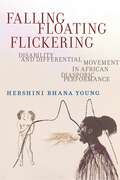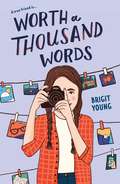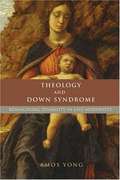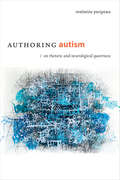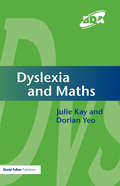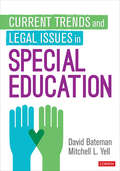- Table View
- List View
Handbook of Infant Mental Health
by Charles H. ZeanahWidely regarded as the standard reference in the field, this state-of-the-art Handbook offers a comprehensive analysis of developmental, clinical, and social aspects of mental health from birth to the preschool years. Leading authorities explore models of development; biological, family, and sociocultural risk and protective factors; and frequently encountered disorders and disabilities. Evidence-based approaches to assessment and treatment are presented, with an emphasis on ways to support strong parent-child relationships. The volume reviews the well-documented benefits of early intervention and prevention and describes applications in mental health, primary care, childcare, and child welfare settings. The chapter on psychopharmacology has been updated for the paperback edition.
Reading Sounds: Closed-Captioned Media and Popular Culture
by Sean ZdenekImagine a common movie scene: a hero confronts a villain. Captioning such a moment would at first glance seem as basic as transcribing the dialogue. But consider the choices involved: How do you convey the sarcasm in a comeback? Do you include a henchman's muttering in the background? Does the villain emit a scream, a grunt, or a howl as he goes down? And how do you note a gunshot without spoiling the scene? These are the choices closed captioners face every day. Captioners must decide whether and how to describe background noises, accents, laughter, musical cues, and even silences. When captioners describe a sound--or choose to ignore it--they are applying their own subjective interpretations to otherwise objective noises, creating meaning that does not necessarily exist in the soundtrack or the script. Reading Sounds looks at closed-captioning as a potent source of meaning in rhetorical analysis. Through nine engrossing chapters, Sean Zdenek demonstrates how the choices captioners make affect the way deaf and hard of hearing viewers experience media. He draws on hundreds of real-life examples, as well as interviews with both professional captioners and regular viewers of closed captioning. Zdenek's analysis is an engrossing look at how we make the audible visible, one that proves that better standards for closed captioning create a better entertainment experience for all viewers.
Shiny Misfits: A Graphic Novel
by Maysoon ZayidBay Ann doesn't think she's a star--she knows it! Now how does she prove it to the rest of the world? This is a hilarious graphic novel about friendship, fame, and fighting for control of your own story, perfect for fans of Nat Enough, Click, and Invisible.Bay Ann wants to shine. No matter what.She's sure her moment in the spotlight has arrived when she wins the school talent show with a showstopping tap routine! But then her classmate and crush, Alyee Maq, causes her to wobble and almost fall. The video of him catching her goes viral, making Alyee an overnight sensation for "helping her." Bay Ann is reduced to her disability and her talent is ignored.Bay Ann doesn't want her classmate to get all the fame, and she is NOT satisfied being anything but the best. She'll do everything in her power to beat Alyee at his own attention-seeking game. With the help of her two best friends, Michelle and Davey Matt, she'll go up against Alyee and his crew to prove she's number one.But as Bay Ann tries to find the thing that really makes her stand out, everything she tries goes disastrously wrong. What if the only way to beat her enemy . . . is to join him?
A Family-Centered Signed Language Curriculum to Support Deaf Children's Language Acquisition (Elements in Sign Languages)
by Razi M. Zarchy Leah C. GeerDeaf children experience language deprivation at alarmingly high rates. One contributing factor is that most are born to non-signing hearing parents who face insurmountable barriers to learning a signed language. This Element presents a case for developing signed language curricula for hearing families with deaf children that are family-centered and focus on child-directed language. Core vocabulary, functional sentences, and facilitative language techniques centered around common daily routines allow families to apply what they learn immediately. Additionally, Deaf Community Cultural Wealth (DCCW) lessons build families' capacity to navigate the new terrain of raising a deaf child. If early intervention programs serving the families of young deaf children incorporate this type of curriculum into their service delivery, survey data suggest that it is both effective and approachable for this target population, so the rates of language deprivation may decline.
Creative Ways to Help Children Manage Anxiety: Ideas and Activities for Working Therapeutically with Worried Children and Their Families
by Fiona Zandt Suzanne BarrettThis book sets out therapeutic activities to help children aged 4-12 years and their families to better understand and manage anxiety. It explains how to work with anxious children, providing a framework for assessment and therapy that draws on CBT, ACT and narrative therapy approaches. Lots of practical tips for therapists are included and important developmental considerations are discussed, including adapting therapy for children with developmental difficulties, and working with families and schools.Over 50 playful therapeutic activities are included, which have been developed through the authors' extensive work with children, giving children an arsenal of coping strategies. They focus on key areas such as understanding anxiety, managing anxious thoughts, and building resilience and use readily available, inexpensive materials and downloadable templates which are provided in the book. This is the perfect tool for therapists looking for playful and purposeful ways to work with children with anxiety.
Manta's Gift
by Timothy ZahnI am not a fan of science fiction, but I have to admit that this is a clever, creative and well-crafted novel. My favorite review: What if James Dean were a twin-tailed manta ray swimming in Jupiter's atmosphere? Bestselling Star Wars novelist Zahn (Angelmass) gives us a tale of teen coming-of-age angst set in the herd society of the Qanska, intelligent herbivores who inhabit the equatorial band of the gas giant. Suspecting them to be non-native life, Earth's corporate masters, the Five Hundred, send in a spy to find their hidden star drive. Facing their own disaster, the Qanska agree, hoping to gain a human perspective on the impending exhaustion of their ecology. What neither side can count on is how the person injected into the Qanskan world will react. Matt Raimey, a 22-year-old paralyzed by a skiing accident, agrees to have his brain transplanted into a Qanska fetus. Given a second chance to be mobile, he also unexpectedly gets another chance to mature. Zahn concentrates more on the psychological processes at work than on the technological. Solutions to problems arise from better emotional and intellectual integrity, not simply larger databases. While the author doesn't get as deep into his characters as they do into Jupiter's depths, his portrayal of Matt/Manta is direct and involving. Qanskan life, looking much like marine reef life on Earth, is intriguingly portrayed, even if the biology of the Qanskan problem is suspect. YA readers looking for more than the usual SF action-adventure should be well pleased. (Publisher's Weekly)
Teaching Adolescents and Young Adults with Autism Spectrum Disorder: Curriculum Planning and Strategies
by Dianne Zager Michael L. WehmeyerTeaching Adolescents and Young Adults with Autism Spectrum Disorder supports teachers in preparing secondary students with autism spectrum disorder (ASD) to succeed in school, work and beyond. Focused on enabling students to successfully pursue further education and meaningful career paths, chapters incorporate person-centered, student-directed planning into instructional programming throughout the text. Featuring helpful vignettes to demonstrate concepts in action, curriculum areas address community living skills, academics, social communication and interaction, and career preparation. Grounded in current research and Universal Design for Learning practices, this guide is an essential resource for educators, therapists, and anyone seeking to create fluid, adaptable programs for students with autism spectrum disorders.
Zorg voor de verstandelijk gehandicapte: Basiswerken verpleging en verzorging
by Yvonne van de VenBehandelt de meest voorkomende onderwerpen en begrippen.<P><P> Koppelt de theorie aan de praktijk door middel van casussen.<P> Behandelt naast de beperkingen ook de mogelijkheden tot ondersteuning.<P> Gaat verder dan de basisprincipes.<P> Zorg voor de verstandelijke gehandicapte laat zien hoe veelzijdig begeleiding aan mensen met een verstandelijke beperking is. Alle onderwerpen en begrippen die regelmatig voorkomen in deze zorg, komen aan bod. Om de theorie dicht bij de praktijk te brengen, is deze gekoppeld aan een casus. Dat maakt het boek aansprekend en goed leesbaar. Ook onderwerpen als wetgeving en kwaliteit blijven op deze manier dicht bij het werk van de verzorgende. De ondersteuning aan mensen met een verstandelijke beperking vindt zo veel mogelijk in de maatschappij plaats. Dit vergt van de verzorgende een aanpassing in houding en begeleiding. Het boek behandelt, naast de beperkingen, de mogelijkheden tot ondersteuning. Mensen met een verstandelijke beperking ervaren vaak beperkingen op lichamelijk, psychisch en sociaal gebied. De combinatie hiervan maakt het noodzakelijk om vanuit een breed perspectief naar cliënten te kijken. Het boek maakt duidelijk dat de rol van de verzorgende centraal staat in de multidisciplinaire begeleiding. Om problemen op tijd te signaleren, is observatie op basis van voldoende basiskennis noodzakelijk. Deze kennis biedt dit boek.
Challenging Barriers to Change: Attitudes Towards the Disabled
by Harold E. Yuker J. Richard BlockThis small book is a lecture given by professors Yuker and Block in 1979 on attitudinal barriers concerning people with disabilities.
Disability and Social Work Education: Practice and Policy Issues
by Francis K. O. Yuen Carol B. Cohen Kristine TowerBridging the chasm between the disabled and a just and fair society takes skill, dedication, and a deep understanding of the issues. Disability and Social Work Education: Practice and Policy Issues presents leading social work experts providing insightful, effective strategies to address the current gaps in the system between social work and those individuals with disabilities. Diverse perspectives on all levels of social work practice are integrated with the basic tenets of social justice, accessibility to services, and human rights. Specific challenges and issues are addressed in work with disabled populations. Disability and Social Work Education: Practice and Policy Issues examines the social construction of disability that connotes inferiority and highlights practical strategies for change. This creative resource gives social work educators, students, and practitioners the opportunity to embrace diverse and creative ways for integrating a generalist social work model in their work with various size systems that are related to disability. Chapters include extensive references, appendixes, tables, and figures to clearly illustrate topics. Topics in Disability and Social Work Education: Practice and Policy Issues include: model curriculum on disabilities that incorporates diverse perspectives of social work practice with individuals who have physical, cognitive, and psychiatric disabilities protecting the legal rights of children and the Individuals with Disabilities Education Act (IDEA) empowering disabled individuals for civil rights to have access to community living the academic process of helping students who are disabled achieve their academic goals components of the Americans with Disabilities Act—and key decisions made by the Supreme Court strategies of intervention for macro change historical overview of family policy and practice as it relates to children and adolescents who are disabled the biopsychosocial framework as an assessment tool to develop interventions the use of the therapeutic relationship and psychodynamic and ecological approaches to social work practices helping clients with disabilities develop adaptive religious and spiritual beliefs disability protests and movements and their implications on social work practice the Capacity Approach and the International Classification of Functioning, Disability and Health as social work tools basic guidelines for undertaking research about and with people who have disabilities Disability and Social Work Education: Practice and Policy Issues is a valuable, unique resource for social work educators, students, and practitioners.
Teaching Students With Communication Disorders: A Practical Guide for Every Teacher
by Dr James E. Ysseldyke Bob AlgozzineFocusing on teaching students with communication disorders, the authors offer practical teaching strategies and provide brief definitions, indicators, and behaviors associated with speech and language disorders.
Working With Families and Community Agencies to Support Students With Special Needs: A Practical Guide for Every Teacher
by Dr James E. Ysseldyke Bob AlgozzineTeachers will find practical guidelines for collaborating with families, applying early childhood intervention, using transition services, involving community agencies and businesses, and identifying post-high school options.
All in Pieces
by Suzanne YoungFrom <i>New York Times</i> bestselling author Suzanne Young comes a heartrending new novel about a girl struggling to deal with anger issues while taking care of her younger brother with special needs. <p>"Anger-management issues." That's how they classified Savannah Sutton after she stuck a pencil in her ex-boyfriend's hand because he mocked her little brother, Evan, for being disabled. That's why they sent her to Brooks Academy--an alternative high school that's used as a temporary detention center. <p>The days at Brooks are miserable, but at home, life is far more bleak. Savvy's struggling to take care of her brother since her mom left years ago, and her alcoholic dad can't be bothered. Life with Evan is a constant challenge, but he's also the most important person in the world to Savvy. <p>Then there's Cameron, a new student at Brooks with issues of his own; a guy from a perfect family that Savvy thought only existed on TV. Cameron seems determined to break through every one of the walls Savvy's built around herself, except if she lets herself trust him, it could make everything she's worked so hard for fall apart in an instant. <p>And with her aunt seeking custody of her brother and her ex-boyfriend seeking revenge, Savvy's fighting to hold all the pieces together. But she's not sure how much tighter she can be pulled before she breaks completely.</p>
The STAR Detective Facilitator Manual: A Cognitive Behavioral Group Intervention to Develop Skilled Thinking and Reasoning for Children with Cognitive, Behavioral, Emotional and Social Problems
by Professor Susan YoungThe STAR Program is designed to teach children and those involved in their care psychological techniques to improve self-control and prosocial competence. The program employs cognitive-behavioral therapy (CBT) principles and uses a child-centered approach to teach attention skills, emotional control, problem-solving, and interpersonal skills to children aged 8-12 who have cognitive, behavioral, social or emotional difficulties. This manual includes designated group sessions to be delivered by healthcare practitioners alongside individual coaching sessions to be provided by a family member or individual carer between each group meeting. Extra materials include PowerPoint presentations, and a Thinking Tools resource, which are available to download from the JKP website.
Raising Exceptional Children: A Guide to Understanding Learning Differences and Empowering Your Child
by Marianne YoungA comprehensive guide to embracing your child's differences and putting them on the right path Parenting a child with special needs doesn't work with a one-size-fits-all plan—it requires a strategy toolbox. Raising Exceptional Children is a thoughtful and compassionate guide that helps you understand the learning and thinking differences of exceptional children and discover tools to help you support your child's growth without limiting their potential. Drawing from her years of experience as a professional advocate and mother, Marianne Young offers a deep and insightful look into the needs of exceptional children as well as much-needed support for you during your parenting journey. Learn to create strategies for addressing a variety of behaviors, creating supportive environments, and empowering them to excel. Your child is exceptional—and you can set them up to lead an exceptional life. Raising Exceptional Children helps you: Explore your child's needs—Covering attention and sensory issues, autism, dyslexia, giftedness, and more, this guide helps you recognize and understand your child's unique differences. Strategize for success—From navigating tough emotions to setting appropriate goals, learn techniques that will help exceptional children develop lifelong skills. Get them learning support—Whether you're interested in special education, homeschooling, or otherwise, discover ready-to-use advice for making sure your child has the right educational opportunities. Get the help you need to make sure your exceptional child has the opportunity to truly thrive.
ASMR (Idiot's Guides)
by Julie Young Ilse BlansertASMR stands for Autonomous Sensory Meridian Response. A way to beat insomnia and reduce stress, ASMR is a relaxed, tingling feeling that many people report having as a response to particular stimuli, such as close personal attention, tapping, or whispering. Idiot's Guides: ASMR offers a clear explanation of its benefits, different trigger types, and how to experience its effects. Bonus content includes exclusive interviews with the top ASMR artists and online video content.
Falling, Floating, Flickering: Disability and Differential Movement in African Diasporic Performance (Crip #7)
by Hershini Bhana YoungInsists on the importance of embodiment and movement to the creation of Black socialityLinking African diasporic performance, disability studies, and movement studies, Falling, Floating, Flickering approaches disability transnationally by centering Black, African, and diasporic experiences. By eschewing capital’s weighted calculus of which bodies hold value, this book centers alternate morphologies and movement practices that have previously been dismissed as abnormal or unrecognizable. To move beyond binaries of ability, Hershini Bhana Young traverses multiple geohistories and cultural forms stretching from the United States and the Mediterranean to Sierra Leone, Nigeria, and South Africa, as well as independent and experimental film, novels, sculptures, images, dance, performances, and anecdotes. In doing so, she argues for the importance of differential embodiment and movement to the creation and survival of Black sociality, and refutes stereotypic notions of Africa as less progressive than the West in recognizing the rights of disabled people. Ultimately, this book foregrounds the engagement of diasporic Africans, who are still reeling from the violence of colonialism, slavery, poverty, and war, as they gesture toward a liberatory Black sociality by falling, floating, and flickering.
Worth a Thousand Words
by Brigit YoungWhether it’s earrings, homework, or love notes, Tillie “Lost and Found” Green and her camera can find any lost thing—until a search for a missing person forces her to step out from behind the lens. Ever since a car accident left Tillie Green with lasting painful injuries, she's hidden behind her camera. She watches her family and classmates through the lens, tracking down misplaced items and spotting the small details that tell a much bigger story than people usually see. But she isn’t prepared for class clown Jake Hausmann’s request: to find his father.In a matter of days, Tillie goes from silent observer to one half of a detective duo, searching for clues to the mystery of Jake’s dad’s disappearance. When the truth isn’t what Jake wants it to be, and the photographs start exposing people’s secrets, Tillie has to decide what—and who—is truly important to her.Worth a Thousand Words is the debut book by Brigit Young.
Theology And Down Syndrome: Reimagining Disability In Late Modernity
by Amos YongWhile the struggle for disability rights has transformed secular ethics and public policy, traditional Christian teaching has been slow to account for disability in its theological imagination. Amos Yong crafts both a theology of disability and a theology informed by disability. The result is a Christian theology that not only connects with our present social, medical, and scientific understanding of disability but also one that empowers a set of best practices appropriate to our late modern context.
Authoring Autism: On Rhetoric and Neurological Queerness
by Melanie YergeauIn Authoring Autism Melanie Yergeau defines neurodivergence as an identity—neuroqueerness—rather than an impairment. Using a queer theory framework, Yergeau notes the stereotypes that deny autistic people their humanity and the chance to define themselves while also challenging cognitive studies scholarship and its reification of the neurological passivity of autistics. She also critiques early intensive behavioral interventions—which have much in common with gay conversion therapy—and questions the ableist privileging of intentionality and diplomacy in rhetorical traditions. Using storying as her method, she presents an alternative view of autistic rhetoricity by foregrounding the cunning rhetorical abilities of autistics and by framing autism as a narrative condition wherein autistics are the best-equipped people to define their experience. Contending that autism represents a queer way of being that simultaneously embraces and rejects the rhetorical, Yergeau shows how autistic people queer the lines of rhetoric, humanity, and agency. In so doing, she demonstrates how an autistic rhetoric requires the reconceptualization of rhetoric’s very essence.
Dyslexia and Maths
by Dorian Yeo Julie KayThis concise text helps the reader to understand why dyslexics find maths difficult and offers practical ideas for supporting them most effectively. It explains which areas of maths dyslexics tend to have particular difficulty with, assesses current teaching philosophies and methods, describes a framework of general learning principles that allow dyslexics to make progress in maths, and outlines a number of specific and effective teaching recommendations. The book helps teachers at primary and secondary levels to better understand the maths performance of dyslexics and gives them an overview of the ways in which dyslexics can best be supported in all aspects of maths learning.
Current Trends and Legal Issues in Special Education
by Mitchell L. Yell David BatemanBuilding and supporting effective special education programs School leaders and special educators are expected to be experts on all levels and types of special education law and services, types of disability, and aspects of academic and functional programming. With the increasing demands of the job and the ever-changing legal and educational climate, few feel adequately prepared to meet the demands. Trends and Legal Issues in Special Education helps you build and support timely, legally sound, and effective special education services and programs. Readers will find: the most up-to-date information on how to effectively implement special education programs, processes, and procedures examination of a wide variety of issues, from developing and implementing individual education programs (IEPs) that confer a free appropriate public education, Section 504, least restrictive environment (LRE), and successfully collaborating with parents, to issues regarding accountability, staffing, bullying, early childhood special education, multi-tiered systems of support (MTSS), evidence-based practices, transition, discipline, and the school-to-prison pipeline extensive references and resources
Current Trends and Legal Issues in Special Education
by Mitchell L. Yell David BatemanBuilding and supporting effective special education programs School leaders and special educators are expected to be experts on all levels and types of special education law and services, types of disability, and aspects of academic and functional programming. With the increasing demands of the job and the ever-changing legal and educational climate, few feel adequately prepared to meet the demands. Trends and Legal Issues in Special Education helps you build and support timely, legally sound, and effective special education services and programs. Readers will find: the most up-to-date information on how to effectively implement special education programs, processes, and procedures examination of a wide variety of issues, from developing and implementing individual education programs (IEPs) that confer a free appropriate public education, Section 504, least restrictive environment (LRE), and successfully collaborating with parents, to issues regarding accountability, staffing, bullying, early childhood special education, multi-tiered systems of support (MTSS), evidence-based practices, transition, discipline, and the school-to-prison pipeline extensive references and resources
